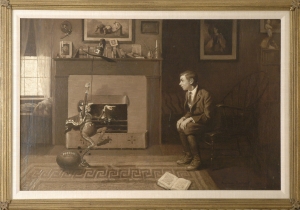
Norman Rockwell (1894-1978)|‘I thought you were wrong,’ he said in triumph. ‘You said it was nine! Stupid.!’|Illustration for "The Magic Foot-ball: A Fairy Tale of To-day" by Ralph Henry Barbour in St. Nicholas (December 1914): 131|Oil on canvas|Norman Rockwell Museum, NRACT. 1973.076
This grisaille illustration and four others were created by Rockwell to accompany a Ralph Henry Barbour story published in St. Nicholas magazine in December of 1914. Barbour (1870-1944) was a popular author in the early twentieth century who wrote more than a hundred stories primarily focused on sport’s ability to alter a boy’s life. In this story Billy Piper’s desire to play football for his school team is thwarted by his small size. In a funk, Billy daydreams himself a star player. As he wishes his dreams to be reality out of a dark corner a fairy emerges describing himself as the Director of Athletics. The fairy gives Billy a magic football in answer to his thrice-stated wish.When Rockwell set out to illustrate this story the way the library looked (where the interchange between the boy and the fairy happens) was left to him to devise. In the foreground are the primary characters of the story, the boy Billy Piper and the gnomish fairy on whose hat the initials D.A. (Director of Athletics) are partially visible.The room’s details emphasize the educated environment in which the boy lives. On the mantle books, ink bottles, brushes and pens standing in a pot, and candlesticks at either end. Behind the boy’s Windsor chair more books are in a bookcase. On the top shelf is a small cast of a standing nude male figure with more books resting against the figure’s legs. Behind the sculpture a framed work of art is partially visible. Between the bookcase and the mantle another work of art hangs on the wall—a three-quarter length portrait from some earlier time since the figure’s clothing appears to be from the 16th century. Over the mantle are three more framed items: at the left is a Rembrandt-like circular head and shoulders of a Burgomiester and under that image hangs a Bowie knife (typically used for hunting and trapping); to the right is a small horizontal piece that might be an image of an older map; and in the middle is a copy of the French artist Jean-Francois Millet’s The Gleaners, from 1857.
Since we know that Rockwell often used references to other art as a signifier of culture or as a reference to the setting or content of the picture, what do we make of the art in this illustration? The Rembrandt-like portrait is of a prosperous probably civic-minded person meant perhaps as a role model for the boy; the Bowie knife underneath it might refer to the ability of a good citizen to provide for his family and his community. The framed map signifies the world to be explored or the worldly possibilities open to a studious young man. The copy of The Gleaners is larger than any of the other art we see. The monumental calm figures of women gleaning wheat from the field are meant to convey their noble character despite the fact that they are picking up the leftovers of a crop that has already been harvested like the Biblical Ruth and her mother-in-law Naomi gleaning in her kinsman’s fields. Gleaning was a poor woman’s lot—the pre-industrial world’s equivalent of going to a food bank. Millet’s use of soft lighting and gentle coloration in the original painting causes it to be viewed it as timeless and the action of the painting as dignified.
And the message? Here is Billy, fixated on the easy win offered by the fairy’s granting of his wish. The author reminds us of the other path the boy could take, honest winning through applied effort versus the magical guaranty of success, by describing his lack of focus on his responsibilities: “Billy’s head was so filled with foot-ball these days that there was almost no room in it for lessons… .” In the end Billy wins the game for the team but the magic ball disappears and under Billy‘s pleasure at the public acclaim is “…a sorrow. The magic foot-ball was gone!” Whatever happens next, Billy will have to exert his own effort to have the desired result.
1. This painting is in the collection of the Musée d’Orsay in Paris.
July 9, 2009
Joyce K. Schiller, Curator, Rockwell Center for American Visual Studies
Norman Rockwell Museum






